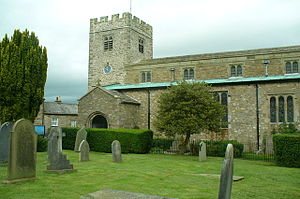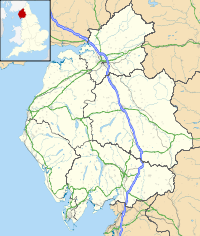- St Andrew's Church, Dent
-
St Andrew's Church, Dent 
St Andrew's Church, Dent, from the southLocation in Cumbria Coordinates: 54°16′41″N 2°27′15″W / 54.2781°N 2.4542°W OS grid reference SD 705 870 Location Dent, Cumbria Country England Denomination Anglican Website St Andrew, Dent History Dedication Saint Andrew Architecture Status Parish church Functional status Active Heritage designation Grade I Designated 16 March 1954 Architect(s) Paley, Austin and Paley
(1889–90 restoration)Architectural type Church Style Norman, Gothic Specifications Materials Stone, stone slate and copper roofs Administration Parish Dent with Cowgill Deanery Ewecross Archdeaconry Craven Diocese Bradford Province York Clergy Vicar(s) Revd Peter John Boyles St Andrew's Church, Dent, is located in the village of Dent, Cumbria, England. It is an active Anglican parish church in the deanery of Ewecross, the archdeaconry of Craven and the diocese of Bradford. Its benefice has been united with that of St John the Evangelist, Cowgill.[1] The church has been designated by English Heritage as a Grade I listed building.[2]
Contents
History
St Andrew's originated in the 12th century, was rebuilt in 1417, restored in 1590, and again in 1787.[3] A further restoration was carried out in 1889–90 by the Lancaster architects Paley, Austin and Paley.[4]
Architecture
Exterior
The church is constructed in rubble stone. The nave has a stone slate roof, and the roofs of the aisles are in copper. Its architectural style is mainly Perpendicular. The plan consists of a nave and chancel in one range with a clerestory, north and south aisles running the whole length of the church, a south porch, and a west tower. The tower has a square-headed south doorway, a small west window, a clock face on the south side, and two-light louvred bell openings. At the top of the tower is an embattled parapet. To the west of the north aisle is a lean-to structure containing a round-headed west doorway. The south porch is gabled with a round-headed doorway, leading to a pointed-arched doorway into the church. Along the sides of the clerestory on each side are four two-light windows in the nave, and two three-light windows in the chancel. The south aisle has a two-light window adjacent to the porch, and four three-light windows to the east of it. Under the fourth window is a round-headed priest's door. On the north side of the church is a blocked round-headed doorway towards the west, then windows similar to those of the south aisle. The east window has five lights, and is flanked by two three-light windows.[2] Norman features have been retained in the blocked north doorway, and in parts of the nave and tower.[3]
Interior
The six-bay arcades are carried on cylindrical and octagonal piers. The chancel is paved with polished Dent marble in a black-and-white chequer pattern. The octagonal oak pulpit is dated 1614, and has a sounding board. There are 17th-century box pews and 18th-century benches in the aisles.[2] The octagonal font is made from Barrow limestone. The stained glass in the east window depicts the Te Deum.[3] The memorials include a marble wall tablet to the geologist Adam Sedgwick who died in 1873. Above the entrance are the Royal arms of George III dated 1792.[2] The two-manual organ was built in about 1892 by H. S. Vincent and Company. It was restored in 2009 by Harrison and Harrison.[5] The ring consists of six bells, all cast in 1787 by William Mears at the Whitechapel Bell Foundry.[6]
External features
The gateway on the south side of the churchyard is listed at Grade II. It consists of a pair of sandstone piers and a wrought iron gate, and dates from the late 18th or early 19th century.[7] Also listed at Grade II is the former grammar school standing in the churchyard, now converted into flats. It is a sandstone building with stone slate roofs, and dates probably from the early 18th century.[8]
See also
- Grade I listed buildings in Cumbria
- List of works by Paley, Austin and Paley
References
- ^ Dent: St Andrew, Dent, Church of England, http://www.achurchnearyou.com/dent-st-andrew/, retrieved 18 October 2011
- ^ a b c d Church of St Andrew, Dent (1383978). National Heritage List for England. English Heritage. Retrieved 18 October 2011.
- ^ a b c St Andrews Church (Dent), Cumbria Directory, http://www.thecumbriadirectory.com/Tourist_Attractions/Abbeys_Monasteries_and_Churches/church_view.php?church=st_andrews_church_%28dent%29, retrieved 18 October 2011
- ^ Price, James (1998), Sharpe, Paley and Austin: A Lancaster Architectural Practice 1836–1942, Lancaster: Centre for North-West Regional Studies, p. 90, ISBN 1-86220-054-8
- ^ Yorkshire, West Riding (Cumbria), Dent, St. Andrew, Main Street {N07027}, British Institute of Organ Studies, http://www.npor.org.uk/cgi-bin/Rsearch.cgi?Fn=Rsearch&rec_index=N07027, retrieved 18 October 2011
- ^ Dent, S Andrew, Dove's Guide for Church Bell Ringers, http://dove.cccbr.org.uk/detail.php?searchString=dent&Submit=+Go+&DoveID=DENT, retrieved 18 October 2011
- ^ Gateway to south side of churchyard of Church of St Andrew, Dent (1383979). National Heritage List for England. English Heritage. Retrieved 18 October 2011.
- ^ Old grammar school in churchyard of Church of St Andrew, Dent (1383980). National Heritage List for England. English Heritage. Retrieved 18 October 2011.
External links
Categories:- Church of England churches in Cumbria
- Grade I listed churches
- Grade I listed buildings in Cumbria
- Norman architecture
- English Gothic architecture
- Diocese of Bradford
- Paley, Austin and Paley buildings
Wikimedia Foundation. 2010.

